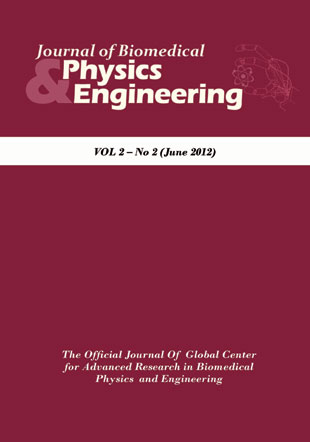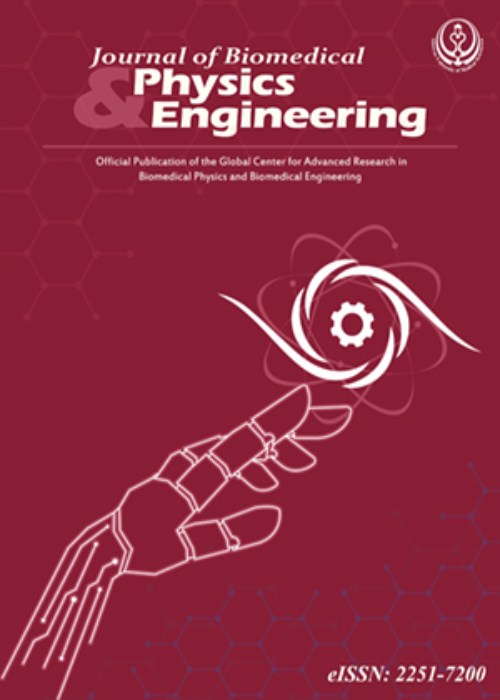فهرست مطالب

Journal of Biomedical Physics & Engineering
Volume:2 Issue: 2, Mar-Apr 2012
- تاریخ انتشار: 1391/04/05
- تعداد عناوین: 6
-
-
Page 47Surface-enhanced Raman spectroscopy (SERS) is a promising tool in the analytical science because it provides good selectivity and sensitivity without the labeling process required by fluorescence detection. This technique consists of locating the target analyte on nanometer range of roughed Au-nanoparticles. The presence of the metal nanoparticles provides a tremendous enhancement to the resulting Raman signal through an electromagnetic enhancement of both the laser excitation light and stokes-shifted light by 5–6 orders of magnitudes. SERS makes it possible to create a spectroscopic device that can act as a highly sensitive molecular detector using Raman signal as a fingerprint of the analyte. In this review, we present a general overview of the recent advancements in SERS as an analytical tool for identification of molecular species with concentrations below biological level in aqueous solution, with a particular attention to its potential applications in biomedicine.
-
Page 54BackgroundOver recent decades, modern protocols of external beam radio¬therapy and radiation techniques such as intensity-modulated radiotherapy (IMRT) have been developed. These methods are extremely sensitive to errors in treatment delivery, so that it is essential to apply a high resolution 3D dosimetry system that has high sensitivity and is capable of measuring and verifying the complex delivery. The ferrous-agarose-xylenol orange (FAX) gels the material properties of which are changed when irradiated have been suggested for such use.ObjectiveIn this study a FAX gel dosimeter was examined for dose linearity for photon and electron beams.MethodsFAX gel was prepared using 0.4 mM (FAS), Fe (NH4)2(SO4)2•6H2O of analytical grade, 25 mM H2SO4 98%, 0.2 mM (XO) xylenol orange-sodium salt, 1% by weight of agarose gel powder and the remaining mass of the solution being highly pure deionized water. FAX gels were exposed to doses up to 20 Gy using 9 MV photon and 6 MeV electron beams by Neptun LINAC. Some general characteristics of FAX such as optical absorbance-dose relationship, sensitivity and reproducibility were analyzed.ResultsAlthough the measurements showed linearity in optical absorbance-dose relationship up to 18 Gy for photons and electrons, oxidation processes continued post-irradiation and storage conditions such as temperature and light affected the response of this dosimeter. The best composition by high sensitivity and stability of dosimeter was found to be 0.4 mM FAS, 0.2 mM XO and 25 mM H2SO4.ConclusionThe above-mentioned FAX gel and UV-visible spectrophotometry as a reader are a sensitive and cheap dosimetry system for radiotherapy.
-
Page 60BackgroundPeritoneal dialysis (PD) is an efficient alternative for hemodialysis. Removal of waste metabolites and excess water from the blood circulation are the two main tasks done during dialysis. These are done by using a filter; in PD, the naturally semi-permeable peritoneal membrane acts as the filter. Automated PD machines control intelligently the operations to enhance the efficiency and survival of patients. Available PD devices, however, have several limitations.ObjectiveTo develop a novel portable automated PD device to be worn by patients.MethodsThe developed device has a peristaltic pump to produce a steady dialysate flow, two flowmeters to measure the volume of dialysate, and a servomotor-actuated triway valve to conduct the dialysate to the right path. Moreover, to disinfect the permanent tubes inside the device an external steam sterilizer was designed. Electrical power of the device is supplied by rechargeable batteries.ResultsTests of a 16×12.5×6 cm3 device revealed that the three phases of dialysis, i.e., injection, dwelling, and drainage, were efficiently performed, and the alarms acted properly.ConclusionThis newly designed automated PD can surmount the social isolation dilemmas of either children or adults, and notably improve their life quality.
-
Page 66BackgroundMelatonin is a free radical scavenger. It has also antioxidant effects through its stimulatory actions on antioxidant system.ObjectiveWe conducted this study to examine the effect of different oral doses of melatonin on liver tissue.MethodsWe used 42 rats—6 rats in each group. Group I served as the control group; group II rats were pretreated with only melatonin; group III was exposed to radiation only; and groups IV to VII were pretreated with different doses of melatonin (10, 100, 200, 400 μg/kg, respectively) and exposed to 6 Gy whole body gamma irradiation.ResultsWhole body irradiation induced liver tissue damage by increasing malondialdehyde (MDA) concentrations and decreasing glutathione (GSH) levels. Hepatic MDA levels in irradiated rats that were pretreated with oral administration of melatonin in Groups V, VI and VII, were significantly decreased, while the GSH levels were significantly increased.ConclusionOral administration of melatonin may prevent radiation-induced liver damage. This radio-protective effect is dose-dependent
-
Page 72BackgroundDielectric barrier discharge (DBD), a source of non-thermal plasma, is used in surface decontamination.ObjectiveTo study the effect of DBD plasma treatment, we evaluated the effect of plasma exposure time on inactivation of Bacillus subtilis.ResultsApplying the DBD plasma to the culture of B. subtilis caused complete sterilization of the surface without any thermal effects. In addition, the inactivated colony-forming units increased as the exposure time rises.ConclusionConsidering the low temperature and non-destructive features of this method, it seems that this method is applicable for fast sterilization of resistant bacteria and hospital sensitive instruments.
-
Page 77BackgroundNeutron contamination in our environment can cause harmful biological effects on human body. Therefore, many efforts have been made to construct a neutron dosimeter to estimate the received dose.ObjectiveTo design a simple neutron dosimeter.MethodsThe primary dosimeter had 3He as a spherical thermal neutron detector encircled by paraffin 10 cm in radius. Then, the paraffin sphere was replaced with ICRU that contains soft tissue and dose equivalent determined as a desired output. Finally, an appropriate relation between counts and dose equivalent was found.ResultsResults on the energies below 1 MeV demonstrated the similarity of changing process of these two quantities, so they could relate to each other with an adequate factor. To find the best fit, different factors considered and the smallest χ2 (goodness of fit) was 1.17×105 At the next step, two covers of cadmium and gadolinium, separately, put around the detector to improve χ2, which was 2.51×104 for cadmium cover and 6.33×103 for gadolinium cover. As we see, gadolinium cover fits the curves of counts and equivalent dose in a better way.ConclusionApplying this simple dosimeter lead us to estimate whole body dose equivalent.


